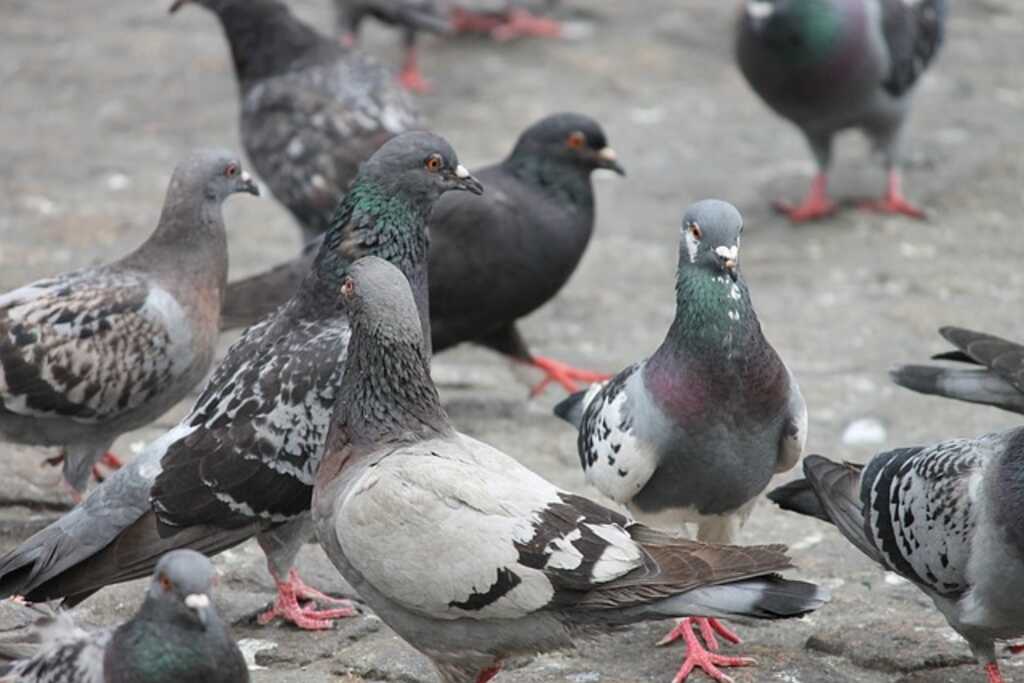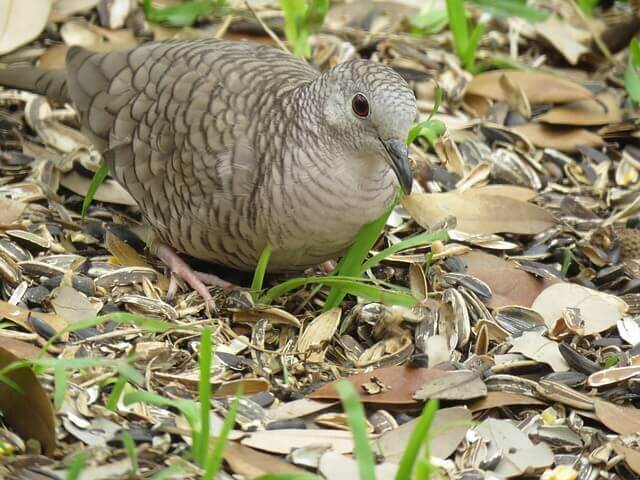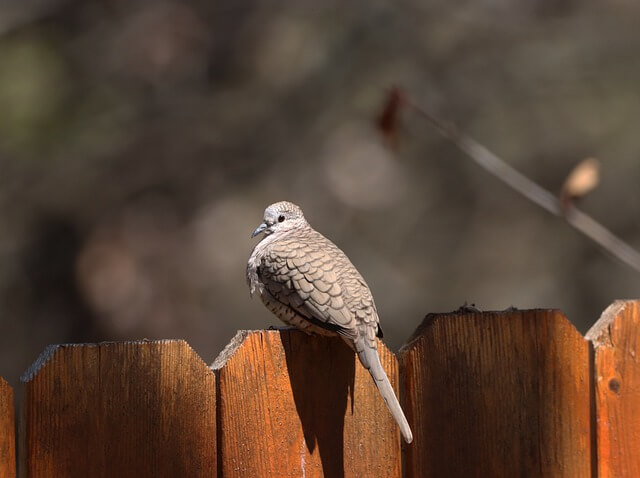Step aside, common pigeon – it’s time to meet some of your feathered doppelgängers! While the rock pigeon is often the most familiar bird to city-dwellers, there are actually many other species of pigeons and doves that share a striking resemblance to our urban feathered friend.
From the sleek Eurasian collared dove to the colorful Victoria crowned pigeon, these birds may look like pigeons at first glance, but each has its own unique features and behaviors that set it apart.
So, let’s take a closer look at 10 birds that look like pigeons but aren’t, and discover the fascinating world of avian lookalikes!
Table of Contents
Rock Pigeon (Overview)
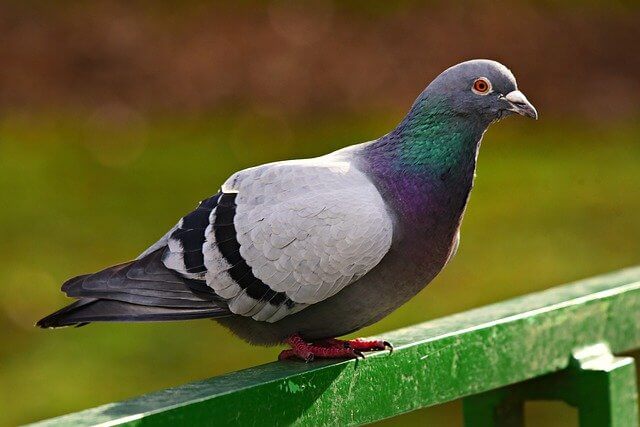
- Length: 11.4-14.2″ in. (29–36 cm)
- Weight: 9.2-13.4 oz (260-381 g)
- Wingspan: 23.6-27.6″ in. (60–70 cm)
- Range: North America, Africa, and Asia
- Habitat: Cities, towns, parks, and gardens
- Food: Seeds, nuts, and fruits
Distribution Range of Pigeons
Pigeons are a widely distributed bird species and are found in many parts of the world, except for the most extreme polar regions and some remote oceanic islands. The exact range of pigeons varies depending on the species, but many are found in both urban and rural environments.
The rock pigeon (Columba livia), also known as the common pigeon or city pigeon, is one of the most widespread and abundant species of pigeons.
It is native to Europe, North Africa, and southwestern Asia, but has been introduced to many other parts of the world, including North and South America, Australia, and New Zealand.
The rock pigeon is commonly found in cities and urban areas, where it often nests on buildings and other structures.
Physical Characteristics of Pigeons
Pigeons are a type of bird in the family Columbidae. They are generally small to medium-sized birds, ranging in size from about 25 to 40 cm (10 to 16 inches) in length.
Pigeons are typically stout-bodied with short necks and small heads. They have short, broad wings and a long, pointed tail.
Pigeons come in a variety of colors and patterns, but the most common coloration is gray with iridescent feathers on the neck and wings.
Habitat and Behavior of Pigeons
Pigeons are highly adaptable birds and are found in a wide variety of habitats, including cities, farmland, and grasslands.
These birds are social creatures and tend to gather in large groups or flocks. Pigeons are also known for their homing ability, which allows them to find their way back to their roosting site even from long distances away.
Diet of Pigeons
Pigeons are omnivorous birds and feed on a variety of foods, including seeds, grains, fruits, and insects. They are often seen foraging for food on the ground or feeding at bird feeders.
In urban areas, pigeons are sometimes considered pests due to their ability to congregate in large numbers and cause damage to buildings and public areas with their droppings.
Birds that look like Pigeons
Band-tailed Pigeon
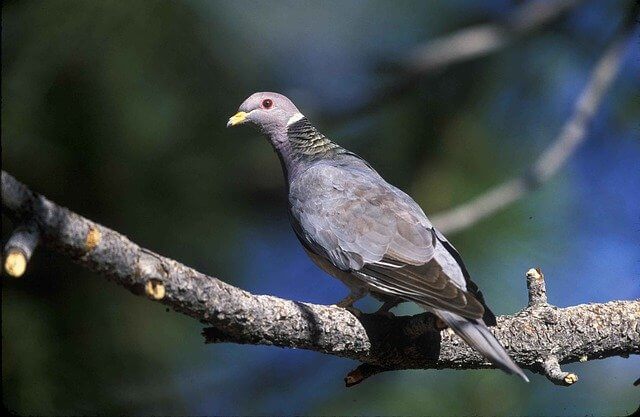
The Band-tailed Pigeon is a plump, medium-sized bird, approximately 14 inches in length, with a distinctive white band on its tail. These birds are known for their swift, direct flight and their melodious, deep cooing calls.
They are found throughout North and South America, ranging from Alaska to Argentina, and are typically found in mountainous forests and oak woodlands. Their diet consists primarily of fruits and seeds, and they play an important role in the dispersal of these plants.
Compared to other pigeons, the Band-tailed Pigeon is a unique species with several distinguishing characteristics. They are larger than most other North American pigeons, and their plumage is a grayish-blue color.
They also have a white neck band and a pale yellow bill. In terms of habitat, they prefer mountainous areas with dense forests and are less likely to be found in urban environments. Their diet is primarily composed of fruits and seeds, but they also consume some insects and snails.
Overall, the Band-tailed Pigeon is an important species for maintaining healthy forest ecosystems and serves as a beautiful and unique sight for birdwatchers to enjoy.
- Length: 13-16″ in. (33-40 cm)
- Weight: 225–350 g (7.9–12.3 oz)
- Wingspan: 10.2″ in. (26 cm)
- Range: North America and South America.
- Habitat: Mixed coniferous, deciduous, and oak forests
- Food: Seeds, berries, nuts, fruits, acorns, insects, wheat, barley, and corn
Mourning Dove

The Mourning Dove (Zenaida macroura) is a small to medium-sized bird that is widely distributed across North and Central America. The bird’s plumage is predominantly brown, with a pinkish-grey breast, and a distinctive black crescent mark beneath its eyes.
Mourning Doves are primarily seed-eaters, and their diet consists of a wide variety of grains and seeds, including corn, wheat, and sunflower seeds. They are also known to feed on insects and small invertebrates.
These birds prefer to nest in trees, shrubs, and other vegetation, and are found in a wide range of habitats, including farmlands, gardens, and suburban areas. Although the Mourning Dove and pigeon belong to the same family (Columbidae), there are several key differences between the two species.
Pigeons are larger than Mourning Doves and have a more robust body. Pigeons are generally more colorful, with iridescent feathers in shades of green, blue, and purple. Unlike Mourning Doves, pigeons have a rounder head and lack the distinctive black crescent mark beneath their eyes.
Pigeons are also more adaptable to urban environments and are commonly found in cities worldwide, whereas Mourning Doves are more prevalent in rural and suburban areas. Both species share a similar diet, primarily consisting of seeds and grains.
- Length: 8.3-13.8″ in. (21-35 cm)
- Weight: 2.9-5.6 oz (82.2-158.8 g)
- Wingspan: 17.7-18.5 in (45-47 cm)
- Range: USA, Canada, Central, and South America
- Habitat: Rural and urban areas
- Food: Seeds, berries, grain crops, weed seeds, and insects
Related Articles: Mourning Dove Facts -10 Things you Need to Know!
Eurasian-collared Dove
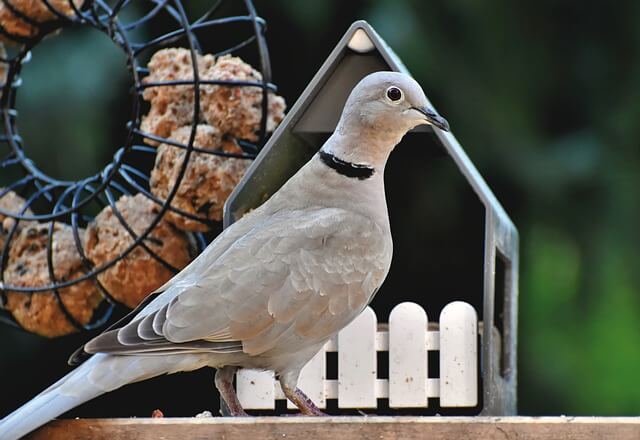
The Eurasian-collared Dove is a medium-sized bird with a distinctive black collar around its neck. They have a light brown body, pointed tail, and reddish feet. These doves are native to Europe and Asia but have been introduced to other parts of the world, including North America.
They thrive in a variety of habitats, including gardens, parks, farmlands, and urban areas. Their diet consists mainly of seeds, fruits, and grains, and they can often be seen foraging on the ground or in trees. Although similar in appearance to pigeons, Eurasian-collared Doves have a few notable differences.
They are slightly smaller than pigeons and lack the iridescent plumage that is common in many pigeon species. Additionally, their coloration is more subdued, with a lighter brown body and reddish feet. Eurasian-collared Doves tend to be less social than pigeons, and they are often seen alone or in pairs rather than large flocks.
They also have a more limited range, with their native habitats being primarily in Europe and Asia, whereas pigeons can be found throughout the world.
- Length: 11.0-12.2 in (28-31 cm)
- Weight: 4.8-6.5 oz (137-183 g)
- Wingspan: 14 in (35.6 cm)
- Range: South-central and Southwestern states, Texas, New Mexico, Oklahoma, Louisiana and Arkansas, Central and South America.
- Habitat: Europe, Asia, North Africa, and South America
- Food: Grains, seeds, and fruit of plants such as wild oats, grapevines.
White-winged Dove
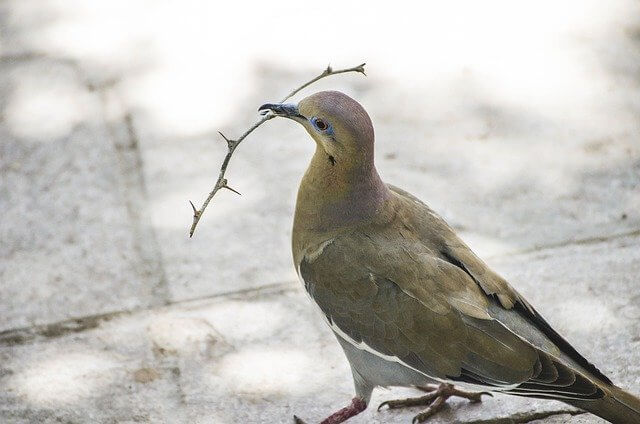
The White-winged Dove is a beautiful bird species that belongs to the Columbidae family. These doves are known for their unique features, including their white wing patches and bluish-gray coloration. These birds can be found in regions of the southwestern United States, Mexico, and some parts of Central America. These doves prefer to inhabit areas with mesquite thickets, desert scrub, and urban areas with ample food sources.
Their diet consists of seeds, fruits, and insects. The White-winged Dove’s distinct call is a series of four coos that become gradually louder and faster. While the White-winged Dove may share some similarities with pigeons, there are many differences that set these two bird species apart.
For starters, pigeons are found all over the world, while the White-winged Dove is only found in specific areas. Pigeons also tend to inhabit more urban areas, while the White-winged Dove prefers more natural habitats.
Additionally, pigeons are larger than White-winged Doves and have a more colorful appearance. Pigeons also tend to feed on more varied diets, including seeds, fruits, and grains, while the White-winged Dove primarily eats seeds and fruits.
Despite these differences, both pigeons and White-winged Doves are known for their gentle nature and cooing calls.
- Length: 11″ inches (27.9 cm)
- Weight: 148-150 g (5.2-5.3 oz)
- Wingspan: 19.5 inches (49.5 cm)
- Range: North America, Central America, and South America
- Habitat: Subtropical or tropical dry forests, lowland forests, mangrove forests, moist montane forest
- Food: Small insects, grains, berries, and seeds
Inca Dove
The Inca Dove is a small, ground-dwelling dove with a unique appearance. They are predominantly brown with white-tipped feathers on the wings and a scaly appearance on the back and neck. These birds have a distinctive call, a low cooing sound, that can be heard throughout their range.
These birds are indigenous to the regions of southwestern United States, Mexico, and Central America. Inca Doves prefer arid and semi-arid habitats, such as deserts, grasslands, and scrublands. They feed primarily on seeds, including those from grasses and weeds, but also eat insects and fruit.
While Inca Doves share some similarities with pigeons, there are also notable differences between the two species. Pigeons are much larger than Inca Doves and have a more robust body structure. Pigeons have a wider range of habitat preferences and can be found in urban and rural environments across the world.
They also have a more diverse diet, which includes seeds, fruits, and insects. Pigeons come in a variety of colors and patterns, while Inca Doves are predominantly brown with a unique scaly appearance.
Additionally, pigeons have a distinctive head-bobbing behavior while walking, whereas Inca Doves walk more smoothly.
- Length: 6.7–9.4 in (17–24 cm)
- Weight: 29–60 g (1.0–2.1 oz)
- Wingspan: 11-13.4″ in. ( 28-34 cm)
- Range: Colombia, Chile, Argentina, Columbia, and Peru
- Habitat: Agricultural fields, grazing land, or even mangroves near rivers
- Food: Insects, seeds, berries, and fruit
Common Ground Dove
The Common Ground Dove is a small bird species found throughout much of the Americas, from the southern United States to Argentina. They are known for their distinctive cooing call and their small size, which ranges from 15-20 cm in length and a weight of 25–41 grams.
They have a reddish-brown head, neck, and breast, with gray-brown wings and a tan belly. Furthermore, they prefer open areas with sparse vegetation, such as grasslands and savannas, and feed on seeds, grains, and insects.
In terms of similarities and differences to the pigeon, both birds belong to the family Columbidae and share a similar diet of seeds and insects. However, the pigeon is much larger, with a length of up to 37 cm and a weight of up to 380 grams.
Pigeons also have a more diverse range of habitats, including urban areas, while the Common Ground Dove prefers more open environments. The pigeon has a more varied coloration, with some species having iridescent feathers, and their behaviors and habits can vary widely depending on the species.
- Length: 14.5″–20 cm (5.7–7.9″ in)
- Weight: 25–41 g (0.9–1.45 oz)
- Wingspan: 11″ in. (27.9 cm)
- Range: Africa, Asia, Europe, Australia, North America, and South America
- Habitat: Grasslands, gardens, or scrubby areas
- Food: Seeds from ground plants such as dandelions, sunflowers, or millet but will also eat insects
Spotted Dove
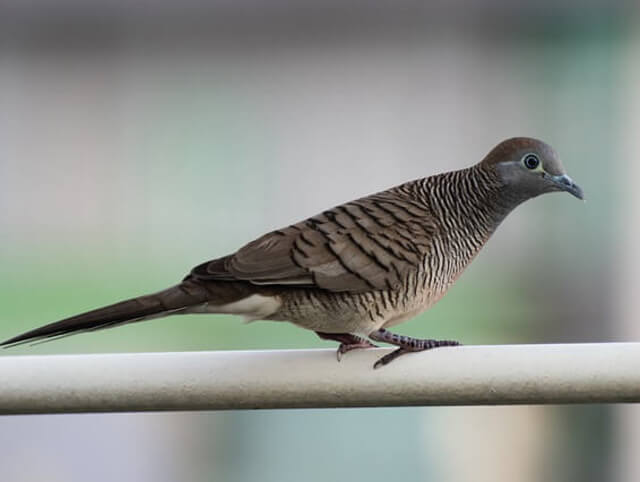
The Spotted Dove (Streptopelia chinensis) is a small, plump bird of the dove family. It measures about 30 cm in length and weighs around 150 g. This dove is easily recognizable by its distinctive spotted feathers, which are light brown with dark spots.
The Spotted Dove has a wide range that extends from South Asia to Southeast Asia and parts of Australia. It prefers open areas with trees and bushes, such as urban parks, gardens, and agricultural land. Its diet consists mainly of seeds, fruits, and grains.
In terms of similarities and differences with pigeons, both the Spotted Dove and pigeon belong to the same family and share some physical characteristics. However, pigeons are generally larger than Spotted Doves and have a more robust build.
Pigeons have a broader range that extends across all continents, except Antarctica. They can be found in various habitats, including cities, forests, and deserts. Pigeons have a similar diet to Spotted Doves, consisting of seeds, fruits, and grains.
However, pigeons are known to scavenge on human food and waste. In terms of appearance, pigeons can have a wide range of colors and patterns, while the Spotted Dove has a more uniform coloration. Pigeons are also known for their cooing call, which is louder and more distinctive than the Spotted Dove’s call.
- Length: 11.8-13.2″ inches (30 – 33.5 cm)
- Weight: 160-165 g (5.64–5.82 oz)
- Wingspan: 16.9-18.9″ in. (43 à 48 cm)
- Range: the United States and Canada. Its range extends from Mexico to the West Coast of Canada, Eastern North America to New England.
- Habitat: Mangrove swamps, farmland, open woodland, orchards, and gardens
- Food: Omnivorous diet which consists mainly of insects but also includes fruits, berries, and seeds
Ruddy Ground Dove
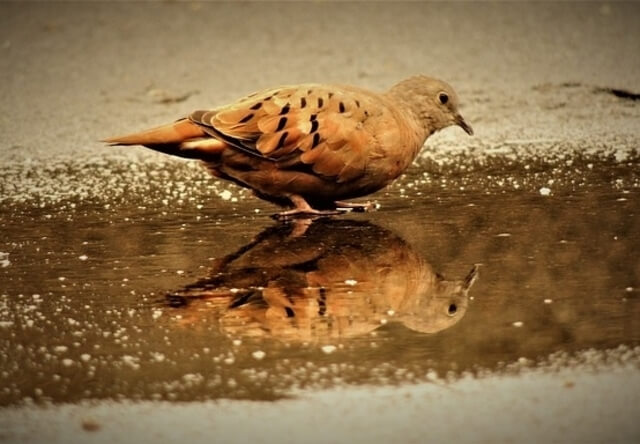
The Ruddy Ground Dove, scientifically known as Columbina talpacoti, is a small, plump bird that measures about 17 cm in length and weighs around 47g. It has a rufous-brown back, a reddish-chestnut head, and a pinkish-brown breast.
This species is distributed across the Americas, from southern Mexico to northern Argentina, and can be found in various habitats, including grasslands, forests, and urban areas. The Ruddy Ground Dove feeds primarily on seeds and grains, but also eats insects and small invertebrates.
Despite their similar appearance to pigeons, Ruddy Ground Doves have distinct differences. While both species are found in a variety of habitats and have a similar diet, Ruddy Ground Doves are smaller and have a more vibrant coloration than most pigeons.
They also tend to live in pairs or small groups, while pigeons are more social and often form large flocks. Unlike pigeons, Ruddy Ground Doves prefer to forage on the ground and only fly when necessary. Additionally, while pigeons are known for their cooing vocalizations, Ruddy Ground Doves produce a soft, throaty whistle.
- Length: 6.7-7.0 in (17-18 cm)
- Weight: 45-47 g (1.6–1.66 oz)
- Wingspan: 11″ in. (27.9 cm)
- Range: Western hemisphere, primarily in Mexico and Central America
- Habitat: Open grasslands and forests with scattered trees
- Food: Mainly of seeds, grains, berries, insects and worms
African Collared Dove
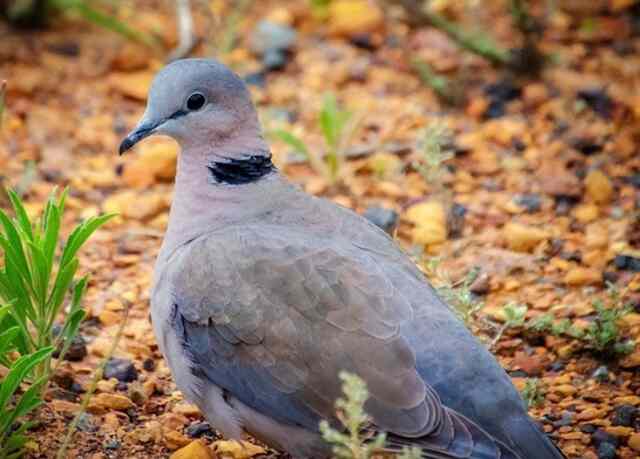
The African Collared-Dove, also known as Streptopelia roseogrisea, is a medium-sized dove that is commonly found in sub-Saharan Africa. These doves have a distinct pinkish-gray coloration with a black collar around their necks, making them easily distinguishable from other dove species.
They primarily inhabit savannas, woodlands, and agricultural areas, and feed on a variety of seeds and grains. They are known for their soft cooing calls and are often seen in pairs or small groups.The African Collared-Dove shares many similarities with the pigeon, including their range, habitat, and diet.
Both species are found in urban and rural areas throughout the world and feed on seeds and grains. However, the African Collared-Dove is generally smaller and has a more slender build compared to the pigeon.
In terms of appearance, the African Collared-Dove has a distinct pinkish-gray color with a black collar, while pigeons can have a range of colors and patterns. Additionally, the African Collared-Dove is known for its soft cooing calls, while pigeons have a more distinct cooing sound.
Overall, while both species share many similarities, the African Collared-Dove has its own unique characteristics that make it a fascinating bird to observe.
- Length: 10.2-10.6 in (26-27 cm)
- Weight: 4.6-5.9 oz (130-166 g)
- Wingspan: 17.7-19.7 in (45-50 cm)
Conclusion
From the sleek Eurasian collared dove to the strikingly beautiful Victoria crowned pigeon, the world of avian lookalikes is full of surprises. While these birds may resemble the common pigeon at first glance, each species has its own unique features and behaviors that make it a marvel of the natural world.
By exploring the world of birds that look like pigeons, we can gain a deeper appreciation for the diversity of life on our planet and the incredible adaptations that enable birds to thrive in a wide range of habitats.
So, the next time you see a pigeon-like bird, take a closer look – you never know what you might discover!
Related Post: Discover 50 Fun Facts about Pigeons (Coos and Surprises!)

